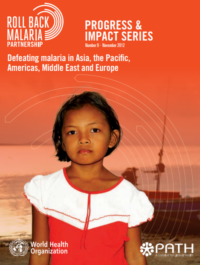Defeating malaria in Asia, the Pacific, Americas, Middle East and Europe (Progress & Impact Series, n. 9)
Collaborator(s): Roll Back Malaria (RBM) Partnership to End Malaria, Switzerland
Published: 01/11/2012
Defeating malaria in Asia, the Pacific, Americas, Middle East and Europe (Progress & Impact Series, n. 9)
This report focuses on countries in Asia, the Pacific, Americas, Middle East, and Europe because of their unique circumstance; many countries are on the brink of eliminating malaria while at the same time facing challenges that aren’t seen elsewhere in the malaria-endemic world.
While the disease burden has been declining in countries with fewer malaria cases and deaths, progress has been slower in countries where the bulk of the disease burden lies: India, Indonesia, Myanmar, Pakistan, and Papua New Guinea (which account for 89% of all malaria cases in the region).
The fight against malaria is further complicated by growing parasite resistance to antimalarial drugs. In recent years, artemisinin resistance in the Greater Mekong subregion has become a major and urgent concern. There is a limited window of opportunity to contain resistant parasites before they spread around the world.
WHO and the Roll Back Malaria (RBM) Partnership have made available global strategies to tackle both drug and insecticide resistance. The Global Plan for Artemisinin Resistance Containment was released in January 2011, while the Global Plan for Insecticide Resistance Management was issued in May 2012. WHO also launched the T3: Test. Treat. Track initiative in April 2012 to urge countries to scale up diagnostic testing, treatment, and surveillance for malaria.
With malaria designated as one of the key priorities on the UN Secretary General’s five-year action agenda (2012–2017), there is an unprecedented opportunity to end the unnecessary suffering caused by this disease.


